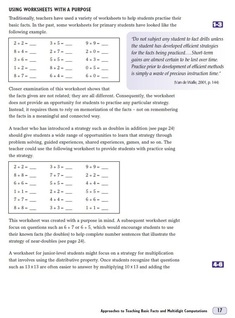
It’s one of the things I really value about this project, actually...
If I am going to blog about “how to teach math effectively” and be authentic about it, I have to be honest about my own practice: Am I using problem-based learning on a regular basis, and how am I meeting the needs of struggling learners in my class? Am I using research-based methods to remediate students who are showing gaps in basic skills? How am I developing automaticity in math facts for my students who have not yet acquired this?
One thing I have enjoyed is reaffirming my “preaching” about skill and drill and kill: I have long held the belief that drilling the facts into students is neither fun nor effective. The students who already know how the add and subtract are bored by it, and the students who struggle become riddled with anxiety (and still do not learn the concept being drilled).
The research confirms my stance.

Page 17 of the Ministry’s GEIM (Vol. 5: Teaching Basic Facts and Multi-Digit Computations) suggests that worksheets without a purpose are simply busywork, and are not only not valuable in learning math, but may even be detrimental for some students:
As the late John VanDeWalle (2004) notes, “Fact mastery relies significantly on how well students have constructed relationships of numbers and how well they understand the operations”, and that we ought not to “subject any student to fact drills unless the student has developed efficient strategies for the facts being practiced. . . . Short-term gains are almost certain to be lost over time. Practice prior to development of efficient methods is simply
a waste of precious instruction time.”
Boy, can I ever related the preciousness of instructional time -- it feels like an ever-present threat in my own classroom this year... so many valuable things to address, and so little time in which to address them effectively!
Imagine my surprise, then, when my own two boys came home from school today with a giant package of subtraction drills! 10 pages of "mad minute", each with 30 questions, from a 1981 resource that – to my knowledge – has been out of use in school boards in this province for at least a decade if not more!!!
I almost fell over!
Marilyn Burns (1995) reminds us that this sort of drill and kill approach to mathematics "makes no instructional sense. . . Children who have difficulty with skills or who work more slowly run the risk of reinforcing wrong practices under pressure. Also, they can become fearful about, and negative toward, their mathematics learning.”
If 300 subtraction questions don’t cause “pressure” for an 8-year-old, I’m not sure what does!
After having a mini-meltdown, I took a deep breath, and reminded myself that not every teacher has the luxury of a 12-thousand-dollar, Ministry-funded research project, and that although it seems odd to me that someone teaching in Ontario in this day and age wouldn’t have long moved beyond this sort of superficial mathematical instruction, we are all at different parts along the continuum (don't ask me, for example, about my Science program, lol!) I am also fully aware that I have not yet heard the teacher's/school's side of the story. In fact, I am eager to meet with the person responsible for sending home this package so that I might learn what the motivation behind such a move might be. I am very open to the possibility that I am about to learn something new.
Oh, how I am reminded of the importance of constant self-reflection as a teacher; critical self examination of one's teaching practices is vital to the longevity of professionalism and effectiveness as an educator.


 RSS Feed
RSS Feed